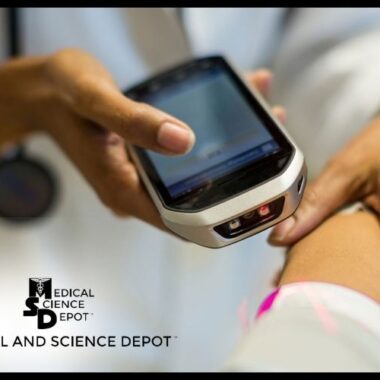Medical research and knowledge are constantly evolving, similar to how medical and surgical equipment and supplies are continually adapted and improved. Health care has never been more comprehensive and advanced — and there are still good things to come! This insight into COPD biomarkers and precision medicine is a heartening example of medical and scientific progress.
COPD biomarkers
“There is rapidly increasing interest in the use of biomarkers in [chronic obstructive pulmonary disease]… In general such data has proven difficult to interpret, largely as a result of weak associations and lack of reproducibility between large patient cohorts,” states the Global Initiative for Chronic Obstructive Lung Disease (GOLD) in their Global Strategy for the Diagnosis, Management, and Prevention of COPD 2023 report.
What are biomarkers? Why are they important in treating and managing diseases like COPD? Why is there increasing interest, despite the difficulties? Why is it difficult to interpret the data?
GOLD actually redefined COPD recently to capture COPD’s heterogeneity, aiming to better describe the different ways people develop COPD and the associated biological mechanisms that gives rise to various phenotypes. The hope is that biomarkers can support this goal, making it easier to identify patients who will respond to pharmacological interventions, those who are more likely to decline more rapidly, and those who may experience frequent exacerbations, just to name a few.
Biomarkers are a pretty simple concept: They are objective characteristics measuring biological processes, such as blood pressure and pulse. They can be complex markers such as blood panels or they can be easily measured in the comfort of one’s home. But not all biomarkers are meaningful in the context of a specific disease nor is it always clear how biomarkers translate to clinical relevance. That’s the first main challenge.
Endpoints: The gatekeepers of clinical trials
But before we get into the complexity of COPD biomarkers, let’s first discuss clinical endpoints. Clinical endpoints are the gatekeepers of clinical research: During the design of clinical trials, endpoints are specifically chosen to evaluate the safety and efficacy of the intervention. Endpoints are demonstrated to adequately evaluate what they’re intended to measure prior to their inclusion in clinical trials through a process called validation. Endpoint validation is an essential process to ensure that medications are correctly identified as the cause of the clinical benefit seen in clinical trials.
There are multiple classes of endpoints: Primary, secondary, and exploratory. Primary endpoints, as their name suggests, are the most important endpoints in gauging the efficacy of the intervention.1Time to first exacerbation and forced expiratory volume in the first second (FEV1) are often primary endpoints in COPD clinical trials.
Secondary endpoints are important, but they are not what defines a clinical trial’s success; they serve in a more supportive role, chosen to demonstrate additional clinical benefits from the intervention. Diseases, medications, and our bodies are all complex; often a therapeutic’s effects are not narrow, so while there may be a primary intention, there can be other beneficial effects, underscoring the additional information gained from secondary endpoints.
The third type, exploratory endpoints, are there for just that purpose: exploration. Researchers include exploratory endpoints not to justify the primary intent of the therapeutic but to explore novel hypotheses.
Endpoints can be either clinical outcome assessments (COAs) or surrogate endpoints. Per the U.S. Food & Drug Administration’s regulatory requirements, clinical outcome assessments must directly “describe or reflect how a patient feels, functions, or survives.” Alternatively, surrogate endpoints indirectly measure how a patient feels, functions, or survives. FEV1, the aforementioned frequent primary endpoint in COPD clinical trials, is actually a validated surrogate endpoint. The FDA considers COAs to be the “most reliable trial endpoints,” but even so, surrogate endpoints as primary endpoints are not rare: 45% of new drugs approved between 2010 and 2012 relied on surrogate endpoints as primary endpoints.
Biomarkers could make precision medicine a reality, but challenges remain
Despite being objective measurements of biological processes, biomarkers do not technically measure how a patient feels, functions, or survives. Biomarkers, when they’re validated as predictive for a specific clinical outcome, are considered surrogate endpoints. There are many categories of biomarkers*:
- susceptibility/risk biomarker
- diagnostic biomarker
- monitoring biomarker
- prognostic biomarker
- predictive biomarker
- response biomarker
- safety biomarker
The wide variance in biomarker categories shown above is exactly why there is so much interest in COPD. Many researchers and clinicians hope to leverage biomarkers for precision medicine. A susceptibility biomarker could be used from the very beginning (even preceding any symptoms or underlying pathology) to understand who is at increased risk of developing COPD (why do some people exposed to noxious particles develop COPD while others don’t?); diagnostic and monitoring biomarkers could be used to complement FEV1 in the diagnostic and management of care. A prognostic biomarker could be used by clinicians to predict which patients are at increased risk of exacerbations. Drug developers and clinical researchers could use predictive, response, and safety biomarkers to improve their clinical trial design and recruitment by seeking out the patients who are likelier to respond to a medication, hopefully reducing attrition and expenditures associated with clinical research.
Of course if it were that easy, there would be plenty of validated biomarkers. As of now, blood eosinophil count is the one biomarker that has been shown to be predictive of whether patients are likely to respond to inhaled corticosteroid use. There are other promising biomarkers, yet none have been validated.
The future of COPD biomarkers
In COPD, the main challenge, alluded to in the initial quote from the GOLD 2023 Guidelines, is that COPD has been mostly studied in broad populations of patients with COPD without characterizing their etiologies and mechanisms of disease compared to age-matched controls. An alternative approach is to use a concept called endotypes, i.e., their disease mechanisms, to subgroup patient populations. Stockley et al. in their review of COPD biomarkers published in American Journal of Respiratory and Critical Care Medicine,concluded:
“Future biomarker studies need to move away from the simplistic approach of comparing patients with COPD with control subjects… and focus on more targeted questions in specific patient subgroups/phenotypes. The concepts of disease endotypes and disease activity are crucial to this future approach. The positive data regarding the ability of blood eosinophil counts (a biomarker of an endotype) in patients at increased exacerbation risk (clinical phenotype) to predict response to [inhaled corticosteroids] integrates some of these concepts, providing an opportunity to use this biomarker to practice precision medicine in patients with COPD.”
Biomarkers are not likely to replace other common endpoints like FEV1, time to first exacerbation, or rate of exacerbations. Instead, endotypes and biomarkers are far more likely to complement historically-used endpoints, giving clinicians and patients an opportunity for personalized precision medicine and improved clinical research.
Is it time to upgrade your medical equipment, add to your inventory, or are you starting a new practice? We are here for you! MSD serves every aspect of medicine and science from start-up to expansion with services, supplies, equipment, consulting, and easy financing. Discover the various and numerous ways we can help you — Call us at 864.982.0460 or find us on Facebook.
Reference: [https://nddmed.com/blog/2023/precision-medicine-in-copd-could-one-day-become-reality-with-the-help-of-biomarkers]













